Specific work instructions (SWI 142.1.2-7): Special crops and new crop inspection procedures
The purpose of pedigreed seed crop inspection is to provide an unbiased inspection and complete a Seed Crop Inspection Report for the Canadian Seed Growers' Association (CSGA) on the isolation, condition, and purity of the crop. It is the seed crop inspector's responsibility to describe the crop as observed at the time of inspection.
Updated: April 2, 2024
On this page
1.0 Scope
This Seed Program specific work instruction (SWI) outlines the procedures that a seed crop inspector will follow in inspecting:
- camelina
- feminized hemp
- industrial hemp
- millet
- niger
- safflower
- sorghum
- sunflower
- tobacco
- sugar beet
- hybrid asparagus
- quinoa
- herbs and spice crops
These crop inspection procedures allow the CSGA to determine that seed crops grown meet the crop standards and requirements for varietal purity as specified by the CSGA's Canadian Regulations and Procedures for Pedigreed Seed Crop Production (Circular 6).
2.0 References
The publications referred to in the development of this SWI are those identified in Seed Program Regulatory Authority Standard SPRA 101 – Definitions, acronyms and references for the seed program. In addition, the following were used:
- Safflower, Carthimus tinctorius L., L. Dajue and H.H. Mundel, 1996, International Plant Gene Resources Institute
- Safflower Production on the Canadian Prairies: revisited in 2004, 2004, H.H. Mundel, Agriculture and Agri-Food Canada
- Alberta Agriculture, Food and Rural Development
- British Columbia Ministry of Agriculture, Food and Fisheries
- Manitoba Agriculture, Food and Rural Initiatives
- Saskatchewan Ministry of Agriculture
- Camelina Production in Montana, K.A. McVay and P.F. Lamb, 2007, Montana State Extension
- Sugar Beet, Canadian Encyclopedia Online
- Asparagus, Encyclopedia Britannica Online
- Testing Guidelines for Distinctness, Uniformity and Stability for Asparagus and Beet, International Union for the Protection of New Varieties of Plants.
- USDA-NRCS, The Plants Database, National Plant Data Center, Baton Rouge, LA 70874-4490 USA, 2003
- Information on Quinoa (Chenopodium Quinoa) for Seed Crop Inspection Procedures. Request: 2018-154. 2019. CFIA Plant Health Risk Assessment Unit.
- Guidelines for Certified Seed Production of Feminized Hemp Seed Varieties and Hybrids (PDF). 2020. Canadian Seed Growers Association.
- Production of Feminized Seeds of High CBD Cannabis sativa L. by Manipulation of Sex Expression and Its Application to Breeding. 2021. M. Flajšman, M. Slapnik, J. Murovec. Department of Agronomy, Biotechnical Faculty, University of Ljubljana, Ljubljana, Slovenia. Frontiers in Plant Science.
3.0 Definitions and acronyms
3.1 Definitions
For the purposes of this SWI the definitions given in SPRA 101 Definitions and the following apply:
- Dioecious
- Having male and female flowers on separate plants
- Feminized hemp seeds
- Seeds that will produce only female plants
- Hybrid
- The first generation progeny of a cross between 2 different plants of the same species often resulting in a plant that is more vigorous or desirable than either parent
- Monoecious
- Having male and female flowers on the same plant
- Somaclonal variant or "sport"
- In feminized hemp, any vegetative reproductive material which differs significantly in appearance from the average of the parental reproductive material
3.2 Acronyms
- AOSCA
- Association of Official Seed Certifying Agencies
- CSGA
- Canadian Seed Growers' Association
- QSP
- Quality System Procedure
- SPRA
- Seed Program Regulatory Authority
- SWI
- Specific Work Instruction
4.0 Specific inspection procedures
Inspection of pedigreed seed crops should be carried out as described in Specific work instructions (SWI 142.1.1): Pedigreed seed crop inspection, with the additional conditions and information provided in the following sections. If the crop is not in Circular 6 or if additional information is required, the inspector should contact Seed Section at SeedSemence@inspection.gc.ca.
4.1 Inspection requirements
Flue cured tobacco, safflower and non-ornamental sunflower varieties require variety registration. Industrial hemp, millet, niger, dill, sorghum, coriander, camelina, fenugreek, asparagus, sugar beet, quinoa, burley tobacco, cigar tobacco, and dark tobacco do not require variety registration. Descriptions are available from CSGA or the grower. Industrial hemp variety descriptions often provide useful information on acceptable variant levels and, for monoecious varieties, a scale that identifies the type or acceptable ratio of male flowers to female flowers.
For industrial hemp, monoecious types (Foundation, Registered, and Certified) require 2 inspections: the first inspection just before or at early flowering and the second inspection when seeds are well forming. Foundation crops of dioecious types also require 2 inspections: the first after flowering when male plants are beginning to senesce and the second when seeds are well forming. Certified and Registered dioecious seed crops require only 1 inspection, which must be made after flowering when male plants are beginning to senesce. These inspections must be recorded on the Hemp Seed Crop Inspection Report form in SeedCert.
For feminized hemp, 2 inspections are required: 1 just prior to any pollen release, and 1 when the pollination period is complete (all male flowers have shed their pollen).
For tobacco, 1 inspection must be made after the crop is in the flower bud stage, usually August, when varietal differences in flowers and plants can be seen.
For open-pollinated sorghum, crops producing Foundation and Registered seed must be given at least 2 crop inspections. The first inspection is done at the half bloom stage. The second inspection must be made after the seed begins to assume a mature colour. Certified seed crops must be given at least 1 inspection after the seed begins to assume a mature colour. Individual inspections should be documented using the Record of inspection for sorghum/millet (appendix I).
For hybrid sorghum, Certified crops of commercial hybrids or Foundation seed stocks must be given at least 3 inspections. The first 2 inspections of the seed parent must be made during bloom: 1 in early bloom and 1 in full bloom. The third inspection must be made after the seed begins to assume mature colour. Individual inspections should be documented using the Record of inspection for sorghum/millet (appendix I).
For hybrid pearl millet, 1 inspection must be performed during the bloom stage but not before at least 50% of the plants are showing 1 or more blossoms.
For self-pollinated foxtail and self-pollinated proso millet, 1 inspection is required after the seed begins to assume a mature colour.
For cross-pollinated foxtail and cross-pollinated proso millet, crops eligible to produce Foundation and Registered seed require 2 inspections. The first is when 50% of plants are showing 1 or more flowers. The second inspection is made after the seed begins to assume a mature colour. Individual inspections should be documented using the Record of inspection for sorghum/millet (appendix I). Certified production requires only 1 inspection, made when the seed turns colour.
For safflower, coriander, niger, dill, camelina, hybrid asparagus and fenugreek, 1 inspection must be performed during the bloom stage but not before at least 50% of the plants are showing 1 or more blossoms.
For sugar beet, 2 inspections are required: 1 when plants are at the early leaf stage and the second when plants are flowering.
For open pollinated sunflower, 1 inspection must be performed after the crop is at least 50% in bloom and before it is fully matured.
For quinoa, the inspection should be done during the bloom stage but not before at least 50% of plants are showing 1 or more blossoms.
4.2 Crop inspection
For hemp, it may be necessary to reduce the size of the count from 10,000 plants to 1000 if the crop is planted with high seeding rates or in narrow rows making it difficult for the seed crop inspector to perform the traditional 6 counts of 10,000 plants/count. The number of counts will then have to increase. If the count size is reduced to 1000 plants then a minimum of 15 counts should be performed for Registered crop production, and a minimum of 10 counts for Certified production. For Foundation plot production, a minimum of 20 counts should be done. Reduced counts should only be used when necessary; full count sizes are preferred.
Hemp may be grown in a field or in a contained growth facility (growth room, greenhouse, polyhouse). The inspector should provide as much information as possible to fully describe the conditions, paying particular attention to the distance to indoor and outdoor contaminating pollen sources. Any additional measures in place to control pollen must be recorded.
Hemp pollen may remain viable for up to 72 hours, and inspectors must be aware of possible pollen transfer from 1 field to the next when planning their inspection schedules. The inspector should discuss this with the grower to determine if any additional measures must be taken to prevent contamination.
For feminized hemp, the following impurities must be reported as off-types: true male (dioecious, XY) plants, monoecious (XX) plants, vegetative reproductive material which differs significantly in appearance from the average of the parental reproductive material, and plants not conforming to the norm of the variety (off-types). When describing these impurities on the report, include whether they are shedding pollen.
For sorghum and millet, if 6 counts of 10,000 plants are not possible, 10 counts of 1000 plants are performed for a total of 10,000 plants.
For niger and dill crops, 6 counts of 30 sq. m each are required for crops for Foundation status and 6 counts of 10 sq. m each are required for crops for Certified status.
For coriander crops, 6 counts of 30 sq. m each are required for crops for Foundation and Registered status and 6 counts of 10 sq. m each are required for crops for Certified status.
For tobacco, isolation distances vary depending on whether the variety is a self-pollinated or hybrid variety. If alternate isolation measures are used in lieu of the required isolation distance, this must be reported in the "Comments" section of the Seed Crop Inspection Report (for example, seed heads bagged prior to pollen shedding). Inspectors are not required to inspect tobacco plants for disease.
For hybrid asparagus, isolation distances vary depending on whether the seed crop is produced in an open environment or an enclosed environment that is in good condition. To be considered in good condition, the mesh (or contained environment) must be free from any breaks in the mesh fabric and the fabric is small enough mesh to prevent pollen escape. Greenhouses with opening windows/vents must have these screens in order to prevent pollen escape. If the environment is not in good condition, an explanation of the problems is required in "Comments." An environment in poor condition means that the mesh obviously cannot prevent pollen escape.
4.3 Completion of the Seed Crop Inspection Report
For industrial hemp and feminized hemp, the Hemp Seed Crop Inspection Report must be completed for each inspection.
For sorghum and millet crops with multiple inspections, submit only 1 Seed Crop Inspection Report in SeedCert. Include the information from all inspections in comments or by uploading supporting documents.
Tobacco, millet, sorghum, hybrid sorghum, industrial hemp, sunflower, and safflower are open pollinated crops, and therefore require large isolation distances. The distance to potentially contaminating crops must be recorded in the Open Pollinated Crops section of the Seed Crop Inspection Report. For example, if none, state "None within XX metres" (XX meaning the required isolation distance).
Appendices
Appendix I: Record of inspection for sorghum/millet
Grower/Applicant name ![]()
Variety name ![]()
Grower/Applicant address ![]()
CSGA Grower number ![]()
Seq. number ![]()
Field number ![]()
Crop code ![]()
Acres ![]()
Dates of inspections
First ![]()
Second ![]()
| Width (m) | Description of isolation strip | Isolation conditions: Good | Isolation conditions: Fair | Isolation conditions: Poor | Adjacent Land contains: (variety and kind if applicable) | |
|---|---|---|---|---|---|---|
| East | ||||||
| South | ||||||
| West | ||||||
| North |
| Inspection date | Impurity Description | 1 | 2 | 3 | 4 | 5 | 6 | 7 | 8 | 9 | 10 | Sub-Total Counts |
|---|---|---|---|---|---|---|---|---|---|---|---|---|
| Time in: | ||||||||||||
| Time out: |
| Inspection date | Impurity description: Definite impurities/ doubfull impurities |
1 | 2 | 3 | 4 | 5 | 6 | 7 | 8 | 9 | 10 | Sub-total counts |
|---|---|---|---|---|---|---|---|---|---|---|---|---|
| Time in: | ||||||||||||
| Time out: |
Appendix II: Diseases that may affect plant appearance
Hemp
Sclerotinia
The symptoms include premature ripening and pale-grey or white lesions on stems, branches and pods. Sclerotia form within the stems, branches and pods. Severely infected crops frequently lodge, shatter at swathing, and make swathing more time consuming.
Quinoa
Downy Mildew (Peronospora farinosa f.sp. chenopodii)
Typical symptoms include pale or yellow chlorotic lesions on the surface of the leaf, which eventually turn necrotic, and grey-violaceous sporulating areas on the lower surface of the leaf. In some cultivars the lesions are small and numerous, whereas in others the lesions are large, diffuse and irregular. Lesions can turn reddish to purple in some cultivars. Systemic infection of plants may lead to dwarfing and yellowing.
Appendix III: Descriptions of special crop species
Asparagus
Asparagus may be erect or climbing, and most of the species are more or less woody. The rhizome-like, or sometimes tuberous, roots give rise to conspicuous, leaf-like branchlets; true leaves are reduced to small scales. Small, greenish-yellow flowers in the spring are followed by red berries in the fall.
Garden asparagus, the most economically important species of the genus, is cultivated in most temperate and subtropical parts of the world. Commercial plantations are not undertaken in regions where the plant continues to grow throughout the year, for the shoots become more spindly and less vigorous each year; a rest period is required. Where climate is favourable and with proper care, an asparagus plantation may be productive for 10 to 15 years or longer. The best soil types for asparagus are deep, loose, light clays, with much organic matter, and light, sandy loams. Asparagus will thrive in soils too salty for other crops, but acid soils are to be avoided.
Distinguishing characteristics of asparagus:
- intensity of green colour of foliage
- plant height
- stem length to first branch
- stem diameter at ground level
- spear tip anthocyanin colouration
- time to spear emergence
- width of first bracts at base of apex
- spear apex shape
- spear base diameter compared to remaining stem
- length of first spear bract at base of apex at harvest time
Camelina
Camelina (Camelina sativa), a cruciferous crop, is grown for oil used both for cooking and fuel purposes. Common names for this species include false flax, large seeded false flax, linseed dodder and gold-of-pleasure. Both spring and winter types exist.
Camelina plants are highly branched and reach 0.3 m to 1 m in height. Plants produce many small pale yellow or greenish yellow flowers consisting of 4 petals. Seed pods are approximately 0.6 cm long and the seeds are very small, pale yellow-brown, oblong and rough with a ridged surface. Seed oil content ranges from 30% to 40%.
This species is adapted to short season, cool climates where excessive heat during flowering does not occur.
Distinguishing characteristics of camelina :
- oil content
- oil composition
- flowering date
- maturity date
- seed size
- yield
- disease resistance
- lodging resistance
Coriander
Coriander (Coriandrum sativum) is an annual plant with an erect branching stem that grows to a height of 0.5 m to 1 m. Both small seeded and large seeded types are grown in Canada, although the large seeded type predominates due to earlier maturity.
There are several diseases that affect the physical appearance of coriander. Aster yellows will cause chlorosis and malformed flowers. Infected plants will often be taller than healthy plants.
Dill
Dill (Anetheum graveolens) is a hardy annual plant that grows to a height of approximately 1 m. The finely cut leaves appear quite feathery and small. Yellowish-green flowers are borne in umbels. Dill is grown as a herb for food flavoring and for its essential oil for the food industry. There are few diseases that affect dill but it is susceptible to Alternaria blight and aster yellows.
Where the description of the variety does not specify the height of tall plants to be considered variants or off-types, the seed crop inspector should report any plant that is 3 head lengths taller.
Fenugreek
Fenugreek (Trigonella foenum-graecum) is a self-pollinated annual legume grown as a spice or forage. The plant is erect, 30 cm to 60 cm in height with a smooth hollow stem. Alternate single trifoliate leaves are borne on a short petiole with 2 small stipules. The leaves are ovate and slightly toothed. The flowers may be creamy white or purple-tinged and develop in the leaf axils singly or in pairs. Pods, each bearing 10 to 20 seeds, are brown, narrow and sickle shaped with a sharp beak.
The seeds are irregularly rectangular in shape and approximately 5 mm x 2.5 mm in size. The seed coat ranges in colour from translucent in white flowered plants to greenish brown in purplish flowered types.
Hemp
Industrial hemp varieties may be dioecious with separate male and female plants or monoecious with both male and female flowers on the same plant.
In male flowers, 5 petals make up the calyx and may be yellow, white or green in colour. They hang down and 5 stamens emerge. Male plants flower 10 to 14 days earlier than female or monoecious plants. Male plants increase in height quicker than the female and monoecious plants. Male plants also have fewer leaves near the top. After pollen shedding, the male plant dies.
The flowering shoot of the female plant (and the female portion of the monoecious plant) is leafy and compact. The tiny female flower is hidden within the bract and 2 tiny styles emerge when the flower is ready for pollination. In monoecious plants, the female flowers on a given branch open first, followed by the opening of the male flowers on the tips of the same branch.
Monoecious varieties of hemp also contain varying numbers of intersexual plants, that is, plants that are neither male, female nor truly monoecious. Intersexual plants may complicate inspections of industrial hemp crops since they have both female and male flowers but usually the male flowers greatly outnumber the female flowers.
Cannabinoids are concentrated in the leaves of female plants. To increase cannabinoid yields, breeders have developed techniques to produce feminized hemp seed (FHS), which will produce only female plants. FHS is generated by fertilization of flowers on a dioecious female plant with pollen from the same plant or another female plant that has been induced to produce pollen ("masculinized"). Masculinization may be induced by using an application of a chemical agent.
Since hemp is a heavy pollinator, inspection staff may choose to take precaution when conducting the inspection by wearing a mask.
Distinguishing characteristics of hemp:
- plant height
- flowering type
- flowering date
- sex expression in dioecious types
- degree of branching
- stem internode lengthFootnote 1
- stem thickness and colourFootnote 1
- anthocyanin presence in male flowers
- leaf size and colourFootnote 1
- average number of leaflets/leafFootnote 1
- middle leaflet length and widthFootnote 1
- leaf colour
- presence and intensity of anthocyanin in leaf and leaf stalkFootnote 1
Millet
The term millet is broadly applied to over 140 species belonging to the genus Pennisetum. The name is a compound form of the Latin words meaning farther and bristle, a term that describes the floral aspects of the spike of some millet species.
Pearl millet is a robust, very rapid growing, erect, tropical, annual, cross pollinated bunch grass. It is an extremely variable species. Culms are solid and pithy and the plants are generally 0.5 m to 5 m in height. Culms may be thick or slender, simple or branched. Plant parts such as the sheath, leaves, and nodes may be smooth or hairy and range in colour from green, purple, and red to golden yellow.
Plants usually have 6 to 12 internodes with a leaf sheath arising from each node, 9 internodes being most common. The initial above-ground internode is the shortest, the uppermost or peduncle the longest. In addition to the above-ground internodes there is a group of very closely spaced internodes underground, giving rise to primary tillers.
Leaf sheaths are split and have a prominent ligule (5 mm) at the juncture of the leaf sheath and blade. Leaf blades are up to 1.5 m long and 7 cm wide and long and pointed with small saw like teeth on the margins. Leaves have a prominent midrib, often pubescent throughout. The inflorescence of pearl millet consists of a single, terminal, dense, cylindrical, spikelike ear somewhat tapering toward the tip. The head is a mostly unbranched false spike ranging in length from 2.5 cm to 205 cm and in width from 0.8 cm to 5.5 cm. A rosette of bracts consisting of bristles and spikelets united at the base and known as an involucre subtends a flower cluster arising from the central rachis. Involucre bracts may drop off or persist at maturity. The involucre itself is borne on stalks about 2.5 cm in length and exhibits fine hairs to finger like projections or bristles. From 1 to 9 fertile spikelets, 3 mm to 7 mm long and borne on a 2 mm long pedicels or rachillae, are present in each involucre. A single spikelet is really a secondary spike having 1 upper and 1 lower floret. The lower floret is staminate or sterile; the upper perfect or fertile floret has 3 anthers and a pistil with 2 feathery stylar branches enclosed between the lemma and the palea. The anthers are large enough for effective cross-pollination.
Under natural conditions, pearl millet can self-pollinate when 1 tiller head that reaches anthesis before other tillers on the same plant. Self-pollination can occur at a rate up to 31%. On large heads, later-emerging stigmas may be pollinated by anthers on the same head, as pollen is shed over a 4 to 7 day period on 1 head. Stigmas remain receptive for 3 days, and pollination is accomplished mainly by wind.
Generally, 1 day after the stigmas have emerged, the anthers start emerging from the centre of the head toward the tip. Anthers emerge in 2 distinct waves. The first wave involves the perfect flowers and the second involves staminate flowers.
Pearl millet anthers have a tuft of fine hair on their tips. Their function is believed to be a way of reducing the speed of anther release. Millet pollen remains viable for an extended period up to 7 hours.
Flowering of plants with many tillers occurs on a 7 to 21 day period. Stigmas emerge when mature, regardless whether or not the head has emerged from the leaf sheath thereby restricting seed set because of lack of pollination. Anthesis starts from the upper third of the head and proceeds towards the base.
Seeds range in colour from light gray, deep gray, and pearly amber to deep yellow and purple. Most common seeds are yellowish gray with a reddish tinge on the embryo.
Seed is smaller than corn, but size is greatly variable. Seeds are typically obovoid, 3 mm to 4 mm long and 2.25 mm wide. Seed protrude from the lemma and palea at maturity, making them susceptible to damage from birds. At maturity, the spike changes from green to brown.
Foxtail millet and proso millet (Panicum miliaceum) are much shorter than pearl millet, growing only 0.25 m to 1 m in height. The seeds remain enclosed in hulls after threshing. Weedy proso millet is commonly called broomcorn.
Distinguishing characteristics of millet:
- flower size, branching and density
- flowering date
- plant height
- stem colour and branching
- flag leaf sheath length and pubescence
- flag leaf blade length and pubescence
- maturity date
Niger
Niger (Guizotia abyssinica) is a leafy annual that grows to a height of approximately 1 m. The serrated leaves are lanceolate to oblong and are approximately 10 cm long. The seed may be cultivated for edible oil or for use in bird seed.
Quinoa
Quinoa (Chenopodium quinoa Willd.) is an annual herbaceous plant native to western and southern South America. A member of the goosefoot family (Chenopodiaceae), it is cultivated for its protein-rich grain and, to a lesser extent, for its edible foliage. Quinoa exhibits a high degree of intraspecific variation and plasticity which allow it to grow under an extremely wide range of climatic and agronomic conditions.
Plants range from 0.2 m to 3 m in height, depending on genotype and environmental conditions but most are 1 m to 2 m tall. The central stem is woody and occurs in a variety of colours (for example yellow, green, red, purple). It often has prominent stripes (striae) of a secondary colour. The central stem may be branched or unbranched, depending mainly on the variety and sowing density.
Quinoa leaves are alternately arranged on the stem and are borne on long, furrowed petioles. Leaves can vary significantly within the same plant as well as among varieties. Leaves are usually green on young plants but may turn yellow, red or purple as the plant matures. The leaf axils may be red or purple. Most leaf blades are flat but in some types are undulating. Leaf edges are smooth, toothed or serrated. Depending on the ecotype, there may be very few or as many as 30 leaf serrations or teeth. Upper leaves are usually lanceolate or triangular and lower leaves are rhomboidal or triangular. Lower leaf blades are up to 15 cm long by 12 cm wide, becoming smaller and less serrated moving upward on the plant. Young leaves are often covered with calcium oxalate glands (papillae).
The inflorescence is a many-branched panicle with a terminal panicle and axillary panicles in the leaf axils along the stem. Each panicle has a main axis from which secondary, and in some cases, tertiary axes arise. Quinoa inflorescences may be amaranthiform, in which small groups of flowers (glomeruli) originate from the secondary axes, or glomerulate, in which the glomeruli originate from the tertiary axes. Both types vary in degree of compactness. Inflorescences range from 30 cm to 80 cm in length and 5 cm to 30 cm in diameter. Inflorescences occur in a variety of colours. The colour of the inflorescence may change as it reaches physiological maturity.
Similar to the rest of the plant, quinoa grains exhibit a wide variety of colours, including but not restricted to white, yellow, orange, red, pink, purple, brown and black. The seeds vary in size from 1.36 mm to 2.66 mm.
Quinoa is predominantly a self-pollinated species, with cross-pollination usually occurring at a rate of 10% or less. Quinoa's nearest relative in North America is the widespread native weed Pitseed Goosefoot (Chenopodium berlandieri Moq.). Morphologically they are very similar, although Chenopodium quinoa often has larger leaves and inflorescences and lighter coloured seeds. Another widespread but non-native weed of this genus, Lamb's Quarters (Chenopodium album), is not cross-compatible with quinoa.
Distinguishing characteristics of quinoa:
- plant heightFootnote 2
- time of floweringFootnote 2
- time of maturityFootnote 2
- stem colourFootnote 2
- inflorescence colourFootnote 2
- seed colourFootnote 2
- presence of stem stripes
- panicle colourFootnote 2
- panicle width
- colour of stem stripes
- panicle density
- foliage colourFootnote 2
- leaf angle of base
- leaf dentation
- leaf size
- stem pigmentation at leaf axil
- foliage glaucosity
Safflower
Safflower, a member of the Asteraceae family, is a branching, thistle like herbaceous plant with numerous spines on its leaves and bracts. It produces a white achene which is usually smooth and may or may not come with tufts of hair on the end adjacent to the plant. Stems elongate quickly and branch extensively with the angle of the branching ranging from 30 to 70 degrees. Each stem has a flower capitulum, enclosed by clasping bracts which are usually spiny.
Flowering begins in the outer circle of florets and moves towards the center of the capitulum. Total bloom can last up to 4 weeks or more depending on the growing conditions. Shades of orange, yellow and red flowers are produced early in bloom and become darker with maturity. It is possible for white flowers to develop but it does not occur on a regular basis.
Leaf sizes vary greatly depending on the environment and the variety being grown. Leaf sizes can range from 2.5 cm to 5.0 cm wide and from 10 cm to 15 cm long. Lower leaves are deeply serrated and generally are spineless. Further up the stem, the leaves develop strong hard spines by full flowering. Some varieties have been developed which are free of spines.
When inspecting safflower, inspection staff should protect themselves from the sharp spines on the plants by wearing an extra layer of clothing and proper foot attire.
Distinguishing characteristics of safflower:
- plant growth habit
- plant height
- leaf length/shape
- leaf margins
- leaf colour
- flower primary head shape
- primary head diameter
- flower colour
- flowering time
- spines on outer involucral bracts
- spine location
- seed colour
- seed shape
Sorghum
Sorghum plants range in height from 61 cm to 6 m. The solid stalks are coarse, and vary in diameter from 1 cm to 5 cm. The stalks are coarse, juicy or pithy, sweet or nonsweet. Each plant has 7 to 20 nodes and internodes. A leaf sheath arises from each node, and in dwarf varieties the sheaths overlap. Leaf blades arise from each leaf sheath, arranged on opposite sides of the stalk, resulting in an alternate leaf arrangement. Leaves are similar in shape to those of corn, but are generally narrower and there is great variation in leaf length and width among varieties.
Sorghum has an extensive, fine and fibrous root system enabling it to extract more moisture from the soil and therefore allowing it to avoid or reduce drought stress. Some varieties are suited to as little as 25 cm of seasonal rainfall.
Sorghum is a self-pollinated crop with no known barriers to cross-fertilization. Cross pollination occurs at a rate ranging from 2% to 35% and averages at about 5% to 6%. Cross pollination is achieved by wind and air currents.
Grain is borne on a branched, terminal panicle that ranges from compact to loose to open. Seed branches arise in whorls and terminate in spikelets containing paired florets. The fertile sessile spikelet has 2 outer glumes, a sterile lower floret and a fertile upper floret. The sterile floret is able to produce pollen.
Fertile florets contain 3 stamens and an ovary with 2 long styles and feathery stigmas arising in a membranous lemma and palea. An awn, if present, arises from the lemma of the fertile floret. At the base of the floret are 2 lodiculae. The glumes, enclosing the spikelets may be black, red brown or straw-coloured.
Flowering proceeds from the top of the panicle downward over a 4 to 7 day period. Stigmas remain receptive for up to 2 days and from 5 to 16 days if unpollinated, depending on environmental conditions. Cool, wet weather delays flowering.
Between 800 and 3000 kernels are carried on a single panicle. Grain is small in size and varies from 2.36 mm to 4.29 mm in diameter. Seeds from a single panicle may vary up to 10% in weight according to their position at the top, middle or bottom portions of the panicle. For some hybrids the top kernels are larger, for others the bottom kernels are larger.
Distinguishing characteristics of sorghum:
- flowering date
- plant height
- compactness of head
- maturity date
- leaf size
- presence of awns
- seed colour
Sugar beet
Sugar beets produce a large, succulent, white, cone-shaped root and a rosette of large leaves in the first year. If they overwinter, they produce large, branched seed stalks up to 2 m high the second year. They are pollinated by wind and will cross readily with other members of the species.
Distinguishing characteristics of sugar beet:
- hypocotyl colour
- root position in soil
- petiole underside colour
- root shape in longitudinal cross-section
- leaf blade blistering and margin undulation
- root tip shape
- root length, width, length to width ratio and colour of exterior and flesh
- leaf blade attitude, shape, colour and colour intensity, length and width
Sunflower
Sunflower is a member of the Asteraceae family, and the genus Helianthus comprises both herbaceous and perennial species. Sunflowers are tall annuals. Modern cultivated varieties of sunflower reach a plant height of between 1.5 m and 2.5 m at flowering and have strong taproots, from which deeply-penetrating lateral roots develop. There is 1 apical inflorescence on a stem of 20 to 30 leaves. The stem is hairy and becomes very fibrous as the plant matures. Leaves are large, dark green and roughly heart shaped, and they have a wrinkled surface and prominent veins. The leaves are individually stalked and arranged round the stem in such a fashion that light interception is maximised. The flower head typically has a maximum diameter of 15 cm to 30 cm. The head is composed of 1000 to 2000 individual flowers joined to a receptacle. The flowers around the circumference are ligulate ray flowers that do not have stamens or pistils. The remaining flowers are disk flowers, which are arranged in arcs radiating from the centre of the head. Varietal differences in maturity are usually associated with changes in vegetative period before the head is visible.
Distinguishing characteristics of sunflower:
- hypocotyl anthocyanin
- leaf size/shape
- leaf number
- leaf colour
- leaf blistering
- leaf attitude
- petiole size
- plant height
- branching type
- head shape/number
- head angle at maturity
- flower bract pubescence
- flower bract shape/size
- ray flower number/shape/colour
Tobacco
The tobacco plant grows from 1 m to 3 m in height and produces 10 to 20 leaves from its central stalk. Leaves are oval to heart-shaped to elliptic and more grow toward the base. Flowers are perfect, large, rose-pink and have swollen corolla tubes and downy undersides.
It is in flower from July to September, and the seeds ripen from August to October.
Distinguishing characteristics of tobacco:
- plant shape
- leaf shape, length and width
- leaf profile (straight or curved)
- leaf tip shape
- inflorescence shape
- plant height
- number of overturned leaves
- average number of leaves per plant
- flowering date
- degree of suckering
Appendix IV: Diagrams of special crop species
Tobacco
Plant shape
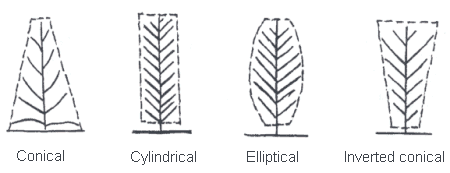
Description of diagram of tobacco plant shape
4 plants are depicted with different shapes – conical, cylindrical, elliptical, and inverted conical
Leaf type
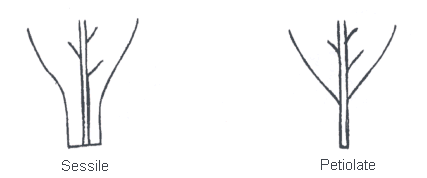
Description of diagram of tobacco leaf type
2 leaf types are depicted – sessile and petiolate
Angle of leaf insertion
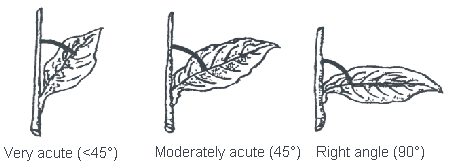
Description of diagram of angle of leaf insertion of tobacco
3 leaf insertion angles are depicted – very acute (<45°), moderately acute (45°), and right angle (90°)
Shape of leaf blade

Description of diagram of shape of leaf blade of tobacco
7 shapes are depicted – cordate narrow, elliptic, ovate, broad elliptic, obovate, lanceolate, and rounded
Shape of leaf tip

Description of diagram of shape of leaf tip of tobacco
5 shapes are depicted – obtuse, slightly pointed, moderately pointed, strongly pointed, and very strongly pointed
Leaf auricles
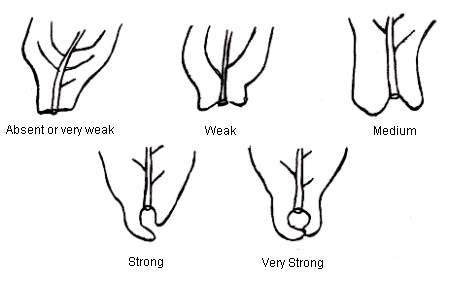
Description of diagram of tobacco leaf auricles
5 leaf auricles are depicted – absent or very weak, weak, medium, strong, and very strong
Leaf shape in cross section

Description of diagram of tobacco leaf shape in cross section
3 shapes are depicted – concave, flat, and convex
Longitudinal profile of leaf
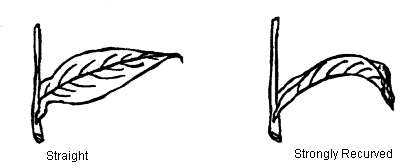
Description of diagram of longitudinal profile of tobacco leaf
2 profiles are depicted – straight and strongly recurved
Width of leaf blade at base

Description of diagram of width of tobacco leaf blade at base
4 widths are depicted – very narrow, narrow, medium, and broad
Inflorescence shape
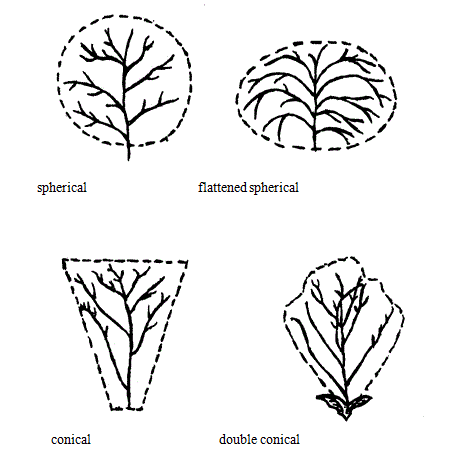
Description of diagram of tobacco inflorescence shape
4 shapes are depicted – spherical, flattened spherical, conical and double conical
Corolla tip shape
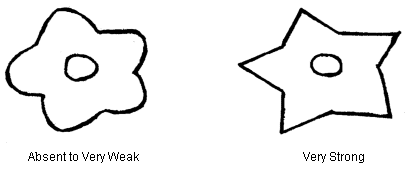
Description of diagram of tobacco corolla tip shape
2 shapes are depicted – absent to very weak and very strong
Sugar beet
Root shape in longitudinal section
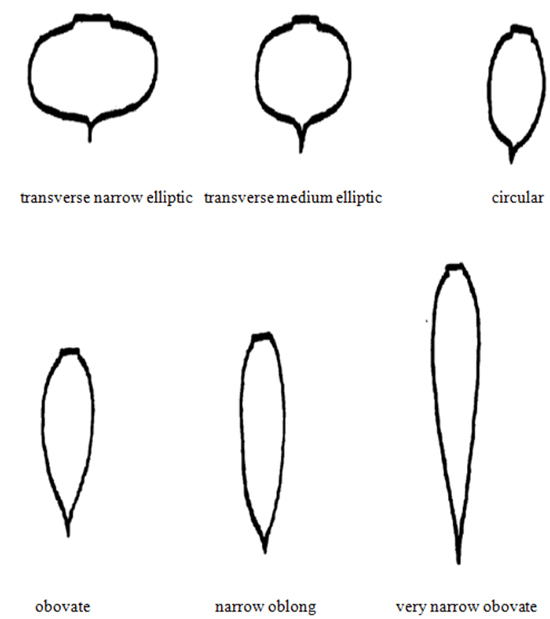
Description of diagram of sugar beet root shape in longitudinal section
6 shapes are depicted – transverse narrow elliptic, transverse medium elliptic, circular, obovate, narrow oblong, and very narrow obovate
Root tip shape

Description of diagram of sugar beet root tip shape
4 shapes are depicted – pointed, rounded, flat, and depressed
Quinoa
Leaf dentation
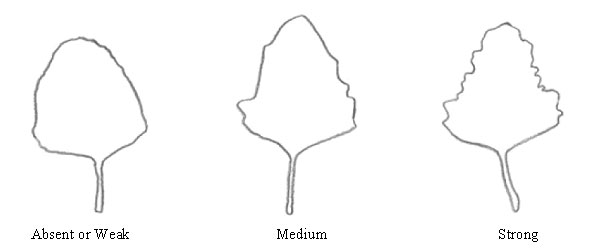
Description of diagram of quinoa leaf dentation
3 shapes are depicted – absent or weak, medium, and strong
Leaf angle of base
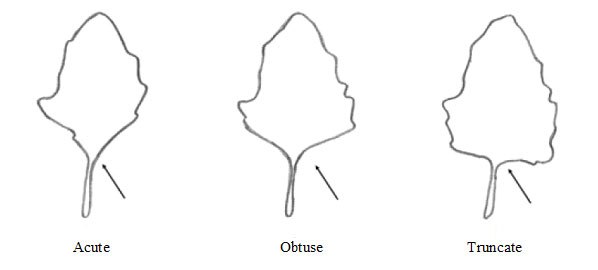
Description of diagram of quinoa leaf angle of base
3 shapes are depicted – acute, obtuse, and truncate
- Date modified:
